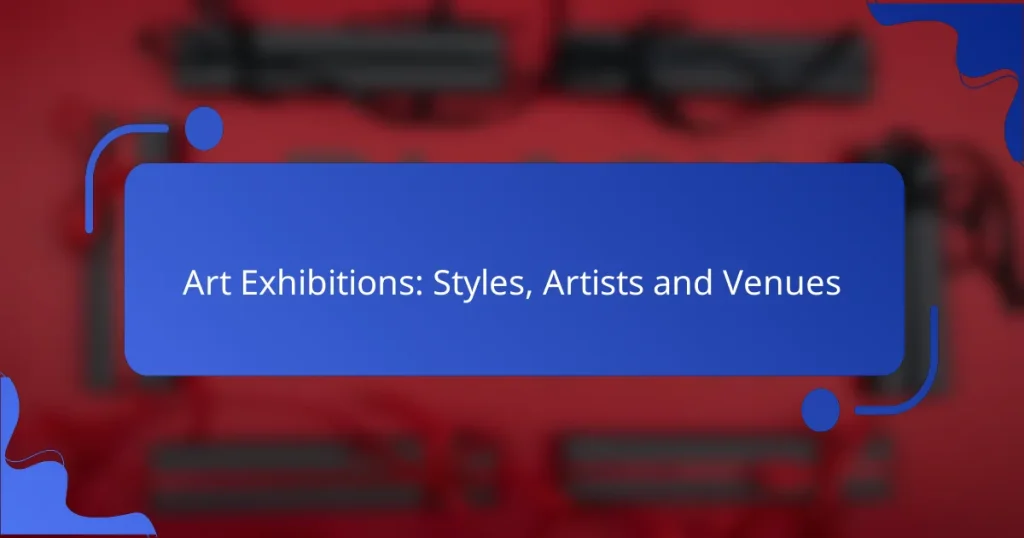Art exhibitions play a vital role in showcasing diverse styles such as contemporary, impressionist, and interactive art, each offering unique experiences that enrich urban cultural landscapes. Featuring renowned artists like Yayoi Kusama and Banksy, these exhibitions attract varied audiences and foster appreciation for artistic expression. To fully enjoy an exhibition, it’s essential to consider your personal preferences, feedback from past attendees, and the accessibility of the venue.
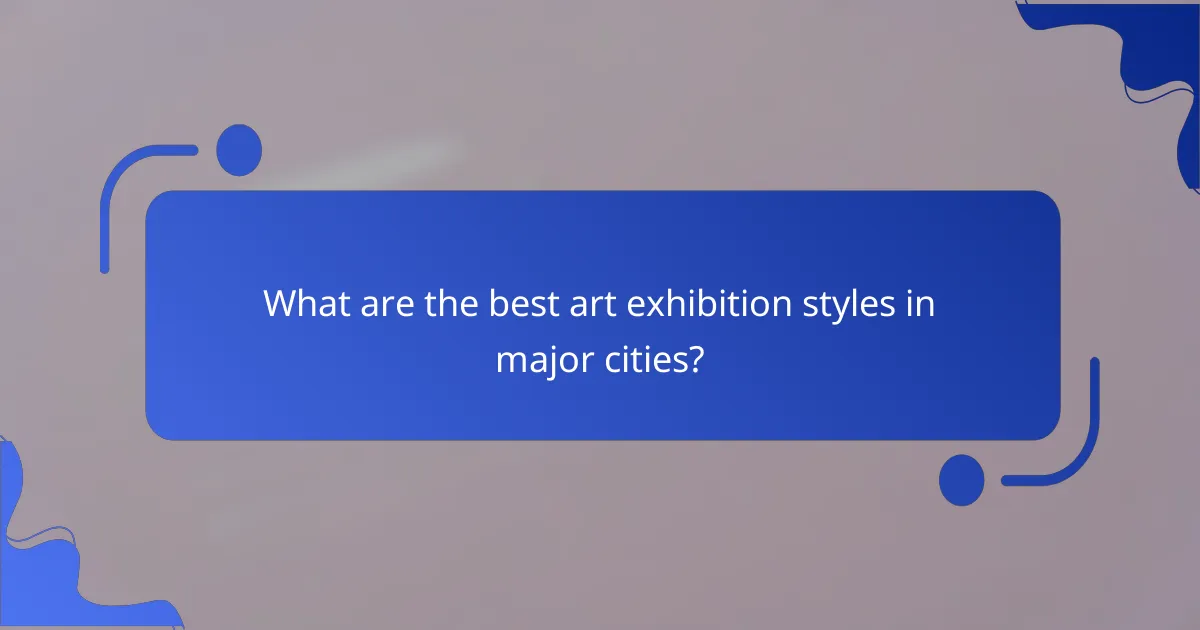
What are the best art exhibition styles in major cities?
The best art exhibition styles in major cities include contemporary, impressionist, modern, photographic, and interactive art. Each style offers unique experiences and attracts different audiences, making them essential to the cultural landscape of urban centers.
Contemporary art exhibitions
Contemporary art exhibitions showcase works created in the late 20th and 21st centuries, often reflecting current social, political, and cultural issues. These exhibitions frequently feature a mix of mediums, including painting, sculpture, video, and installation art.
Major cities like New York and London host renowned contemporary art fairs, such as Art Basel and Frieze, where emerging and established artists display their work. Visitors should be prepared for thought-provoking pieces that challenge traditional notions of art.
Impressionist art exhibitions
Impressionist art exhibitions focus on the works of artists from the late 19th century, characterized by their loose brushwork and emphasis on light and color. This style includes famous figures like Claude Monet and Edgar Degas, whose paintings capture fleeting moments in everyday life.
Cities like Paris and Chicago often feature exhibitions dedicated to impressionism, showcasing both masterpieces and lesser-known works. Attendees can expect to see iconic pieces alongside educational materials that provide context about the artists and their techniques.
Modern art exhibitions
Modern art exhibitions encompass a broad range of styles from the late 19th century to the mid-20th century, including movements like cubism, surrealism, and abstract expressionism. These exhibitions often highlight the evolution of artistic thought and experimentation during this transformative period.
Venues such as the Museum of Modern Art in New York and the Tate Modern in London regularly host modern art exhibitions. Visitors should look for guided tours that explain the significance of the works and the artists’ intentions.
Photographic art exhibitions
Photographic art exhibitions display works that capture moments through the lens, ranging from fine art photography to documentary styles. These exhibitions can showcase both historical and contemporary photographers, offering insights into various cultures and perspectives.
Major cities frequently host photography festivals, such as the Paris Photo fair, where visitors can explore diverse themes and techniques. Attendees should consider attending artist talks or panel discussions to gain deeper understanding of the medium.
Interactive art exhibitions
Interactive art exhibitions invite audience participation, often incorporating technology or immersive environments. These exhibitions encourage visitors to engage with the artwork, creating a personal connection and enhancing the overall experience.
Cities like Tokyo and San Francisco are known for their innovative interactive art installations, where visitors can influence the art through their actions. When attending, be open to exploring and interacting, as these experiences can be both entertaining and enlightening.
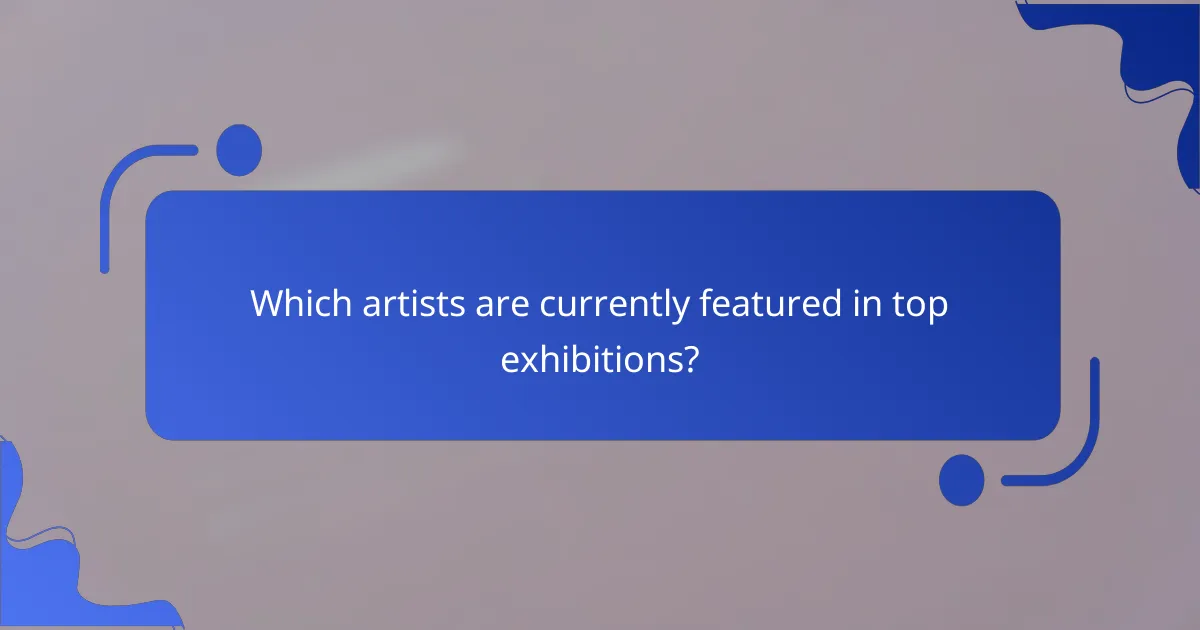
Which artists are currently featured in top exhibitions?
Currently, prominent artists like Yayoi Kusama, Banksy, Damien Hirst, Frida Kahlo, and Ai Weiwei are showcased in major art exhibitions worldwide. These artists are known for their unique styles and impactful works that resonate with diverse audiences.
Yayoi Kusama
Yayoi Kusama is celebrated for her immersive installations and polka dot motifs. Her exhibitions often feature large-scale environments that invite viewer interaction, such as her Infinity Mirror Rooms, which create a sense of endlessness through reflective surfaces.
Visitors can expect to see her signature use of color and repetition, which reflects her personal experiences and mental health journey. Kusama’s work is currently featured in several major cities, including New York and Tokyo, making it accessible to a global audience.
Banksy
Banksy continues to captivate audiences with his provocative street art that often comments on social and political issues. His exhibitions typically include a mix of original pieces and installations that challenge the status quo.
Currently, Banksy’s work can be seen in various exhibitions across Europe, where his pieces are presented alongside discussions on art’s role in activism. Collectors and fans alike are drawn to his anonymity and the mystery surrounding his identity.
Damien Hirst
Damien Hirst is known for his controversial and thought-provoking works that explore themes of life and death. His exhibitions often include his iconic spot paintings and preserved animals, which provoke discussions about mortality and the value of art.
Hirst’s latest exhibitions are taking place in major art hubs like London and Los Angeles, where visitors can engage with his bold concepts and intricate craftsmanship. His work frequently challenges traditional notions of art, making it a must-see for contemporary art enthusiasts.
Frida Kahlo
Frida Kahlo’s art, characterized by vivid self-portraits and exploration of identity, is experiencing a resurgence in popularity. Her exhibitions often highlight her personal struggles and cultural heritage, making her work deeply relatable.
Current exhibitions featuring Kahlo can be found in various locations, including Mexico City and major cities in the United States. These shows typically include her paintings, personal artifacts, and photographs that provide insight into her life and artistic journey.
Ai Weiwei
Ai Weiwei is a prominent Chinese artist and activist known for his politically charged works that address human rights and freedom of expression. His exhibitions often combine traditional Chinese art forms with contemporary issues, creating a powerful dialogue.
Currently, Ai Weiwei’s work is on display in several international venues, including Berlin and London, where he challenges viewers to reflect on social justice. His installations are known for their scale and impact, often incorporating everyday materials to convey profound messages.
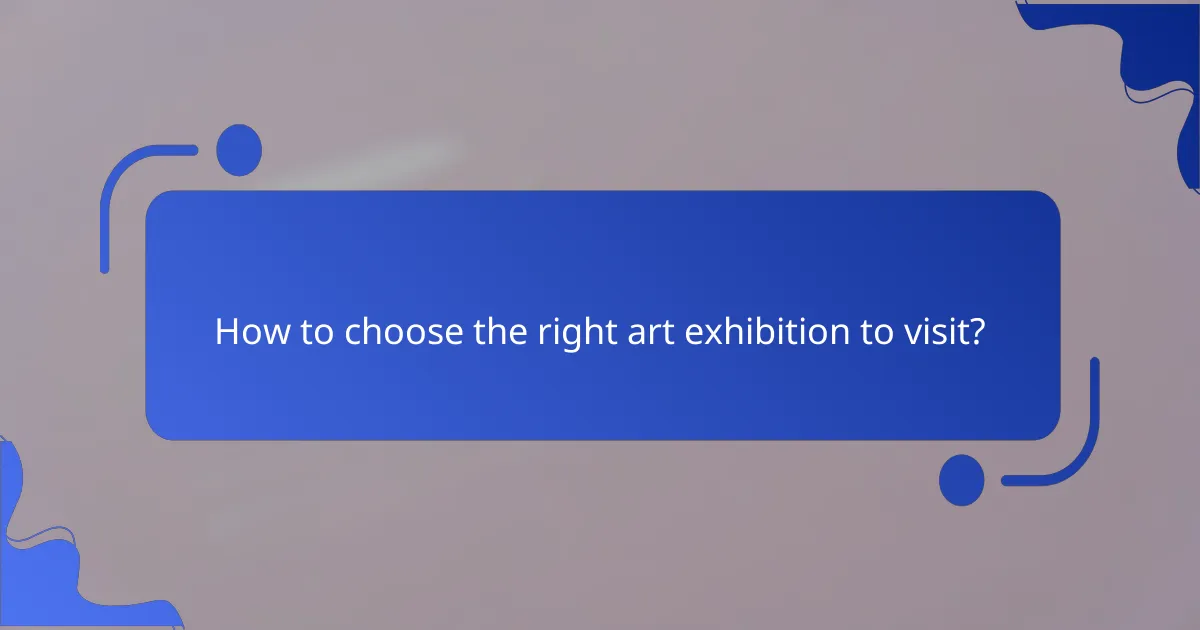
How to choose the right art exhibition to visit?
Selecting the right art exhibition involves understanding your personal tastes, reviewing feedback from previous attendees, and considering practical aspects like venue accessibility. By focusing on these elements, you can enhance your overall experience and ensure the exhibition aligns with your interests.
Consider personal interests
Your personal interests play a crucial role in choosing an art exhibition. Reflect on the styles and themes that resonate with you, whether it’s contemporary art, classical pieces, or specific artists. This self-awareness will guide you toward exhibitions that you are more likely to enjoy.
Additionally, consider the medium of the artwork. If you prefer paintings, look for exhibitions that feature renowned painters or specific art movements. If you are drawn to sculpture or installation art, seek out events that highlight those forms.
Check exhibition reviews
Reading exhibition reviews can provide valuable insights into the quality and appeal of the event. Look for reviews on art-focused websites, social media platforms, or local publications to gauge the experiences of others. Pay attention to comments about the curation, the artwork on display, and the overall atmosphere.
Consider both professional critiques and visitor feedback. While critics may offer in-depth analysis, visitor reviews can highlight practical aspects such as crowd sizes and accessibility, which can influence your decision.
Evaluate venue accessibility
Accessibility is a key factor when choosing an art exhibition venue. Ensure that the location is easy to reach via public transport or has ample parking if you plan to drive. Check if the venue accommodates individuals with disabilities, including wheelchair access and accessible restrooms.
Additionally, consider the size of the venue. Larger spaces may host more visitors, which could impact your experience. If you prefer a quieter environment, look for smaller galleries or exhibitions during off-peak hours.
Look for guided tours
Guided tours can enhance your understanding and appreciation of the artworks on display. Many exhibitions offer tours led by knowledgeable guides who can provide context, background information, and insights into the artists’ intentions. This can be particularly beneficial for complex or thematic exhibitions.
Check the exhibition’s schedule for tour times and whether they require advance booking. Some venues may offer free tours, while others might charge a small fee. Participating in a guided tour can enrich your experience and make the visit more engaging.

What are the top venues for art exhibitions in the United States?
The United States boasts numerous prestigious venues for art exhibitions, each offering unique experiences and collections. Key locations include major museums known for their extensive collections, innovative exhibitions, and cultural significance.
The Museum of Modern Art (MoMA)
The Museum of Modern Art, located in New York City, is renowned for its influential collection of modern and contemporary art. With works from artists like Vincent van Gogh and Andy Warhol, MoMA showcases a diverse range of styles and mediums.
Visitors can explore various exhibitions, including paintings, sculptures, photography, and film. MoMA also hosts educational programs and events, making it a vibrant hub for art enthusiasts.
The Getty Center
The Getty Center in Los Angeles is famous for its stunning architecture and beautiful gardens, alongside its impressive art collection. The center features European paintings, drawings, sculpture, and decorative arts, primarily from the Middle Ages to the 19th century.
Admission to the Getty Center is free, but parking fees apply. Its location offers breathtaking views of Los Angeles, enhancing the overall experience for visitors.
The Whitney Museum of American Art
The Whitney Museum of American Art, also in New York City, focuses on 20th and 21st-century American art. It highlights the works of living artists and often features exhibitions that reflect contemporary themes and issues.
The museum’s unique architecture and outdoor terraces provide a distinctive viewing experience. Regular events and programs engage the community and foster a deeper appreciation for American art.
The Art Institute of Chicago
The Art Institute of Chicago is one of the oldest and largest art museums in the United States, housing an extensive collection that spans thousands of years. It is particularly known for its Impressionist and Post-Impressionist paintings, including works by Monet and Renoir.
Visitors can enjoy a variety of exhibitions, educational programs, and special events throughout the year. The museum’s iconic bronze lion statues at the entrance are a popular photo spot for tourists.
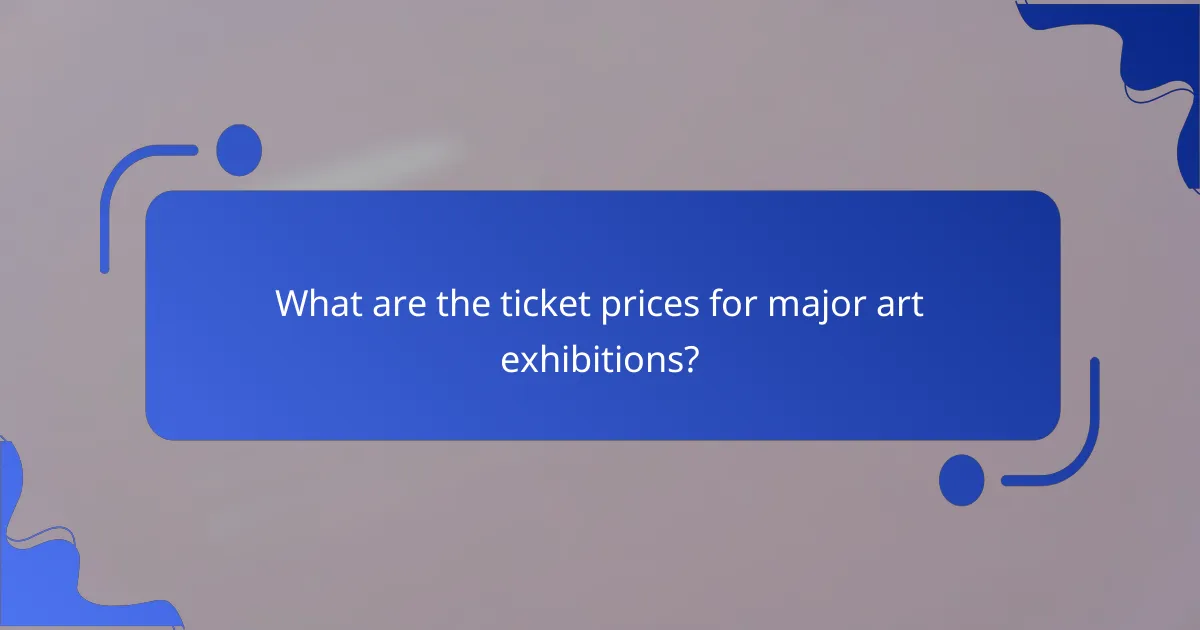
What are the ticket prices for major art exhibitions?
Ticket prices for major art exhibitions can vary widely depending on the venue, location, and the prominence of the artists featured. Generally, prices range from around $10 to $30 for standard entry, with special exhibitions or events potentially costing more.
Average ticket prices
The average ticket prices for art exhibitions typically fall between $15 and $25. Major museums and galleries may charge higher fees for blockbuster exhibitions, sometimes reaching up to $50 or more for exclusive access or guided tours.
In some cases, discounts may be available for students, seniors, or groups, which can reduce the cost significantly. It’s advisable to check the venue’s website for any promotional offers or free entry days, which many institutions host regularly.
For example, prominent art fairs or temporary exhibitions in major cities like New York or London might have higher ticket prices, while smaller local galleries often offer more affordable options. Always consider the value of the experience, including additional amenities like audio guides or workshops that may be included in the ticket price.
